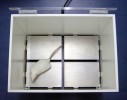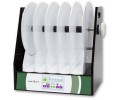Authors
C. Favre-Guilmard, M. Auguet, P.-E. Chabrier.
Lab
Ipsen Innovation 5, Les Ulis, France.
Journal
European Journal of Pharmacology
Abstract
In addition to inhibition of acetylcholine release in the neuromuscular junction botulinum toxin type A (BoNT-A) also inhibits the release of mediators involved in pain perception. We have investigated the effect of two types of BoNT-A on mechanical hyperalgesia in the rat models of carrageenan-induced hyperalgesia and of paclitaxel-induced peripheral neuropathy. A subplantar (s.p.) injection of BoNT-A in the ipsilateral hindpaw 3 days before carrageenan administration reduced hypersensitivity. Dysport® and Botox® elicited comparable antihyperalgesic effects. Dysport® up to 30 U/kg and Botox® up to 20 U/kg did not impair the rat withdrawal nociceptive reflex or the locomotor performance as assessed by the rotarod test. Intraperitoneal administration of the skeletal muscle relaxant dantrolene produced, in contrast to BoNT-A, more motor impairment than analgesia. Paclitaxel treatment resulted in a peripheral neuropathy that affected the two hindpaws. Injection of 20 U/kg (s.p.) Dysport® produced a significant antihyperalgesic effect in the injected paw of neuropathic animals 3 days after administration. Unexpectedly, a similar analgesic effect was observed in the contralateral paw. The same results were also observed when Botox® was used instead of Dysport®. In contrast, a contralateral administration of Dysport® in the carrageenan test was ineffective. We conclude that BoNT-A elicits antinociceptive effects independent of the effects on muscular relaxation. Our results suggest that different mechanisms of action are responsible for the effect of BoNT-A in inflammatory and peripheral polyneuropathic rat models.
BIOSEB Instruments Used:
Aron Test or Four Plates Test (LE830),Rotarod (BX-ROD)

 Pain - Thermal Allodynia / Hyperalgesia
Pain - Thermal Allodynia / Hyperalgesia Pain - Spontaneous Pain - Postural Deficit
Pain - Spontaneous Pain - Postural Deficit Pain - Mechanical Allodynia / Hyperalgesia
Pain - Mechanical Allodynia / Hyperalgesia Learning/Memory - Attention - Addiction
Learning/Memory - Attention - Addiction Physiology & Respiratory Research
Physiology & Respiratory Research
 Pain
Pain Metabolism
Metabolism Motor control
Motor control Neurodegeneration
Neurodegeneration Cross-disciplinary subjects
Cross-disciplinary subjects Muscular system
Muscular system General activity
General activity Mood Disorders
Mood Disorders Other disorders
Other disorders Joints
Joints Central Nervous System (CNS)
Central Nervous System (CNS) Sensory system
Sensory system

